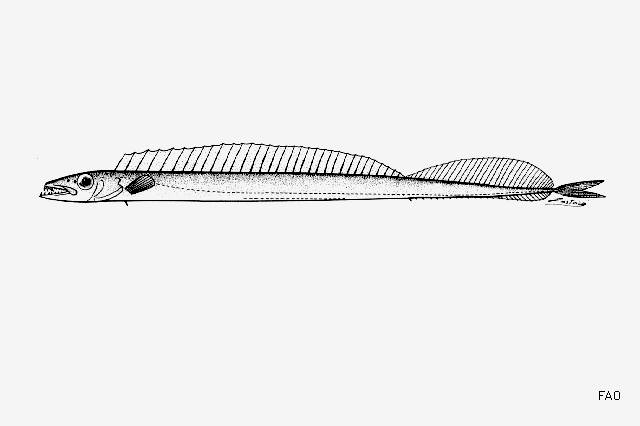- Classification
- ACTINOPTERYGII
- PERCIFORMES
- GEMPYLIDAE
- Diplospinus
- multistriatus
Striped Escolar, Diplospinus multistriatus Maul 1948

Illustration of a Striped Escolar, Diplospinus multistriatus. Source: FAO / EOL. License: CC by Attribution-Noncommercial
Summary:
A silver snake mackerel with many (about 50) very fine longitudinal dotted lines along the side, and black gill membranes. The anus is bout midway between the snout tip and the caudal fin, distance from the anus to the anal-fin origin approx equal to head length (much greater than the snout length). The anterior part of the anal fin has almost no fin membrane.
Cite this page as:
Bray, D.J. 2022, Diplospinus multistriatus in Fishes of Australia, accessed 27 Jun 2025, https://fishesofaustralia.net.au/Home/species/2528
Striped Escolar, Diplospinus multistriatus Maul 1948
More Info
|
Distribution |
Off Northwest Shelf, Western Australia; also the Lord Howe Rise and Norfolk Ridge in the Tasman Sea within Australia's EEZ. Elsewhere the species is circumglobal in tropical and warm temperate seas. An oceanic, mesopelagic species that likely forms schools during the day, migrating upward to 100 to 200 m at night. |
|
Features |
Dorsal fin XXX-XVI,35-44; Anal fin II,28-35; Pectoral fin 10-11; Pelvic fin I; Vertebrae 57-64. Body extremely elongate, compressed; lower jaw extending anterior to upper jaw with a small conical dermal process; upper jaw with 3 immovable, and 3-4 movable fang-like teeth anteriorly. Anus situated midway between tips of snout and caudal fin (in front of first anal fin spine by distance equal to or greater than snout length). Pelvic fin comprising one minute spine; first dorsal fin base about twice length of second dorsal fin base. Anterior portion of anal fin almost lacking fin membrane. Lateral line single, positioned closer to ventral profile than dorsal profile posteriorly. |
|
Feeding |
Feeds on crustaceans and small fishes. |
|
Biology |
Females mature at ~16 cm, and produce about 1200 eggs throughout the year. The eggs and larvae are pelagic. |
|
Etymology |
The specific name multistriatus is from the Latin multi- (= many) and striatus (= striped), in reference to the many (about 50) very fine longitudinal lines along the side. |
|
Species Citation |
Diplospinus multistriatus Maul 1948, Boletim do Museu Municipal do Funchal 3(6): 42, fig. 17. Type locality: Madeira (stomach content). |
|
Author |
Bray, D.J. 2022 |
|
Resources |
Striped Escolar, Diplospinus multistriatus Maul 1948
References
Boltachev, A.P. 1986. Some peculiarities of the distribution and behaviour of Diplospinus multistriatus Maul (Gempylidae) in the Southeast Atlantic. Voprosy Ikhtiology 26(5): 715-719 (in Russian).
Iwamoto, T. 2015. Diplospinus multistriatus. The IUCN Red List of Threatened Species 2015: e.T20665551A20682738. https://dx.doi.org/10.2305/IUCN.UK.2015-4.RLTS.T20665551A20682738.en. Accessed on 15 February 2022.
Hureau, J.-C. & Monod, T. (eds) 1973. Checklist of the Fishes of the North-Eastern Atlantic and of the Mediterranean (CLOFNAM). Paris : UNESCO Vol. 1 683 pp.
Nakamura, I. & Parin, N.V. 1993. FAO Species Catalogue. Snake mackerels and cutlassfishes of the world (families Gempylidae and Trichiuridae). An annotated and illustrated catalogue of the Snake Mackerels, Snoeks, Escolars, Gemfishes, Sackfishes, Domine, Oilfish, Cutlassfishes, Scabbardfishes, Hairtails, and Frostfishes known to date. Fisheries Synopsis No. 125, Vol. 15. Rome : FAO 136 pp. 200 figs.
Nakamura, I. & Parin, N.V. 2001. Gempylidae, Trichiuridae. pp. 3698-3720 in Carpenter, K.E. & Niem, T.H. (eds). The Living Marine Resources of the Western Central Pacific. FAO Species Identification Guide for Fisheries Purposes. Rome : FAO Vol. 6 pp. 3381-4218.
Parin, N.V. 1986. Gempylidae. pp. 967-973 in Whitehead, P.J.P., Bauchot, M.-L., Hureau, J.-C., Nielsen, J. & Tortonese, E. (eds.) Fishes of the north-eastern Atlantic and the Mediterranean. UNESCO, Paris. Vol. 2.
Strasburg, D.W. 1964. Postlarval scombroid fishes of the genera Acanthocybium, Nealotus, and Diplospinus from the central Pacific Ocean. Pacific Science 18(2): 174-185. http://hdl.handle.net/10125/551 ; also see ref at BHL
Sutton, T.T., Hulley, P.A., Wienerroither, R., Zaera-Perez, D. & Paxton, J.R. 2020. Identification guide to the mesopelagic fishes of the Central and South East Atlantic Ocean. FAO, Rome: i-xvi + 1-327. https://doi.org/10.4060/cb0365en



